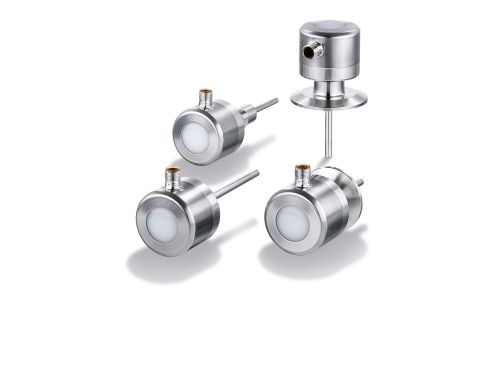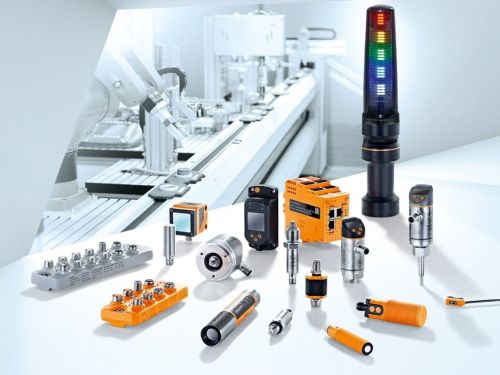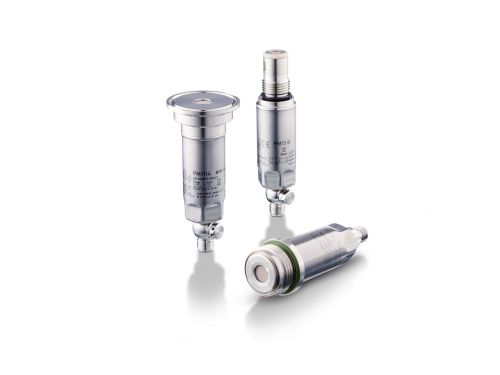Käserei Wildberg – Sensors in the cheese factory
Why a Swiss cheese dairy relies on sensors from ifm for the production of its specialities
Even in times of fully automated food production, the cheese dairy Käserei Wildberg still uses a great deal of expert knowledge and craftsmanship during the crucial stages of cheese production.
Here, in the Zurich Oberland, an exquisite taste experience is conjured up from high-quality milk provided by selected farmers in the area using sophisticated recipes, including cheese maturing processes that take several years. The key to success is sophisticated automation in the background: A wide variety of sensors help to ensure that the numerous process parameters will be precisely adhered to. This is the only way to ensure consistently high product quality.
When you enter the new production halls with managing director Roland Rüegg, you will quickly realise that the staff at Wildberger Käsemanufaktur know their trade: everyone here knows their job and is a master of their profession, all processes interact like cogwheels. The cheese cellars reveal the enormous range of products and recipes. The portfolio ranges from popular specialities such as Emmentaler AOP and mozzarella to the company’s own invention, the Cheebab, a cheese kebab.
The latter has enjoyed great popularity with customers from near and far since the first tastings at the in-house sales stand. The recipe for success: highest quality. Production has been running in the new building since spring 2021. The cheese dairy is equipped with state-of-the-art process technology from staedler automation AG. The automation specialist is located only a few kilometres away and relies on products and solutions from ifm for plant monitoring with sensors.
Cheese and sensors
What, however, does traditional cheese-making have to do with sensors? A lot, because the production machines in the cheese dairy can only be controlled with the precision that is required to ensure the necessary quality if the control system itself is supplied with constantly accurate process parameters.
Example: From the milk feed into the separator via the heat exchanger to the cheese maker, especially temperature and pressure must be precisely kept at a specific level in order to be able to treat the milk appropriately. But, let’s start at the beginning: The freshly delivered milk is cooled down and stirred in the storage tanks in the milk reception area. Here, level and temperature sensors monitor whether the milk is properly stored. The CIP system that is used to regularly clean the piping and tanks is also monitored by sensors. Flow sensors, for example, control the water quantities during the rinsing processes.
Maximum reliability for temperaturecritical processes
During the thermalisation process, in particular temperature sensors are proving their strengths. Depending on the type of cheese, the raw milk will be heated in a plate heat exchanger in a precise and exactly timed manner. Paired TA2502 temperature sensors detect the inlet and outlet temperature in each of the three segments of the heat exchanger to enable the control system to precisely and immediately readjust the temperature in the corresponding downstream heat exchanger segments.
Self-monitoring temperature sensor
Without a doubt, the TCC501 temperature sensor bears the greatest responsibility in the entire process and is positioned at the heat retention section of the heat exchanger where the milk is microbiologically optimised and safely prepared for further processing by maintaining the temperature over time.
Permanent status checking
The special feature of the TCC: The temperature sensor not only measures with great accuracy, it also enables plant operators to react to drift behaviour on an eventrelated basis - and not only at the next scheduled calibration interval. Thanks to the calibration check technology, the TCC permanently checks its own drift behaviour. The sensor compares the temperature value to the simultaneously measured reference value. If the deviation is outside the tolerance range, which can be set between 0.5 and 3 K, the TCC provides an optical signal and sends a message to the central controller via IO-Link and the diagnostic output. The same applies to cases of serious malfunctions. The TCC thus reduces the risk of losing entire production batches due to incorrect production temperatures, especially in the case of fresh products.
Quality assurance thanks to eventrelated measures
Particularly in production processes where exact temperature values are decisive for the product quality, it is important that the measured values are absolutely accurate. Thanks to the inline calibration process, the TCC achieves an accuracy of ± 0.2 K across the entire measuring range. This makes it ideal for use in these temperature-sensitive processes. The microbiological process of the fresh products is thus reliably monitored at all times.


Picture 1: For particularly process-critical locations: self-monitoring temperature sensor TCC with visual status display.

Magnetic inductive flow sensors in the permeate stage of the reverse osmosis system monitor and control the concentration of the whey.

The heart of the plant: plate heat exchanger for accurate temperature control of the raw milk.
Transparent sensor communication
Visual and digital indication: The TCC thus communicates the current status transparently and unambiguously by any means: If the LED on the sensor is green, the unit operates reliably. Blue indicates a temperature deviation outside the tolerance range. Red indicates a serious malfunction, such as a failure of the main measuring element. Besides, the TCC automatically stores all the data required for consistent documentation via IO-Link: installation date, operating hours, temperature histogram as well as logbooks on event messages (operating hours and event number) and on the calibration check status (operating hours, temperature value, drift value, limit and status).
Simulation mode: guaranteed reliability even before installation
The value from which the TCC provides a message can be defined via software. In the simulation mode, the process temperature and the reference temperature, among others, can be freely selected to verify whether the sensor has been correctly integrated into the controller. This process simulation completes the high level of reliability offered by the TCC.
Robust design for long-time use
Thanks to its fully welded and sealed housing and a new measuring probe design, the TCC is permanently resistant to external influences such as moisture, thermal and mechanical shocks and vibrations.
G½ pressure sensor with hygiene approval for small pipelines
Another important sensor for the Wildberg cheese dairy is the PM15 pressure sensor. It monitors the pressure conditions in the heat exchanger with the aim of always ensuring that the pressures in the thermised (i.e. heated) aseptic milk are higher than on the opposite side of the heat exchanger plate where there is either fresh milk or hot water. In case of possible cracks in the heat exchanger plate, only the milk can escape due to the excess pressure. Then again, no foreign media can enter the highly sensitive production process. If deposits form on the heat exchanger plate, causing the pressure to rise at an otherwise constant flow rate, the pressure sensor can make this circumstance transparent to the controller so that it can be readjusted accordingly or a maintenance interval can be initiated.
Ideal solution for hygienic production plants
The new PM15 pressure sensor has a unique flush sealing system with Teflon and PEEK. For the first time, this allows the hygienic integration of small ceramic capacitive measuring cells in small pipelines from DN25. Thanks to the minimised G 1/2 thread, installation is possible without requiring expensive adapters. The adaptation is certified for aseptic applications and is free of any dead space to prevent deposits and ensures optimimum cleaning during the CIP process.
Maintenance-free and robust
The sensor is thus designed without an elastomer seal on the process side and is therefore maintenance-free. The flush, robust ceramic measuring cell is extremely stable in the long term and withstands pressure and vacuum impacts as well as the effects of abrasive substances. It is a "dry measuring principle" since no pressure transfer fluid is used, thus eliminating the risk of critical liquids being released into the medium. The sensor is thus practically wear-free. It can withstand medium temperatures of up to 150 °C (max. 1h), which would allow steam cleaning. The EHEDG certificate, FDA approval and 3A standard confirm its suitability for hygienic processes.


Picture 1: Compact and hygienic: pressure sensor of the PM15 series with flush ceramic measuring cell. Picture 2: Ideal for small nominal widths: pressure sensor of the PM15 series with G1/2 process connection in the feed of the reverse osmosis system.
Improved performance thanks to IO-Link
Like almost all ifm sensors, the PM15 also has IO-Link. In addition to the classic analogue signal (4...20 mA), the process value can be transmitted digitally without loss.
But, IO-Link offers even more: The sensor also has a temperature probe whose value the user can retrieve via IO-Link.
Advantage: In non-critical applications, this non-invasive temperature measurement can be used to achieve more transparency and safety in the system "by the way" - this saves material and installation costs. Other convenient features of IO-Link are zero-point calibration and scaling of measuring ranges.

The company staedler automation AG has implemented the process control of the cheese dairy. All process values can be viewed on the control system.
Conclusion
Not despite, but because of the automatic process monitoring, it is possible for the Wildberg cheese dairy to concentrate on the production of individual cheese specialities, while the required equipment fulfils its task reliably and precisely. Precisely designed sensor technology ensures simple and reliable monitoring of production, even in places with special challenges.




